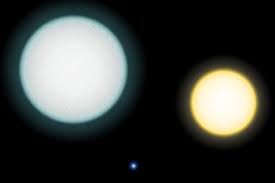Oldest-known white dwarf found

Washington: A volunteer citizen scientist working with a NASA project has found the coldest, oldest-known white dwarf, and it’s surrounded by rings of dust and debris, according to a study published in The Astrophysical Journal Letters. Researchers believe it may be the first white dwarf known to have multiple rings.
A white dwarf is what’s left after a sun-like star dies, and the remnant is usually Earth-size. This peculiar white dwarf, LSPM J0207+3331, is 145 light-years away in the Capricornus constellation.
And it’s 3 billion years old, with a temperature of about 10,500 degrees Fahrenheit. It was initially much hotter, because white dwarfs cool slowly as they age. Dusty disks and rings had previously been found only around white dwarfs that were much younger than J0207.
When a sun-like star reaches the end of its life and burns through all of its fuel, it puffs up to form a red giant and blasts out about half of its mass. Nearby planets and asteroids become consumed by the blast. The hot white dwarf is left behind, and any planets and asteroids that survived move farther out because the star no longer has the same gravitational pull on them.
The same thing will happen in our solar system one day, so learning as much about this process as possible helps inform astronomers about our own distant future.
Between 1% and 4% of white dwarfs emit a signal that indicates a dust ring or disk, possibly leftover from the asteroids and comets pulled around the star and ripped to pieces. Those pieces eventually float down to the star’s surface.
This white dwarf’s signal was initially picked up by NASA’s Wide-field Infrared Survey Explorer mission, known as WISE, when it mapped the entire sky in infrared light.
Marc Kuchner, an astrophysicist at NASA, leads the Backyard Worlds: Planet 9 project, which invites volunteers to look through data from WISE and help make discoveries.
“This object was found by Melina Thévenot of Germany using the Backyard Worlds project,” Kuchner said. “She originally thought it might be a cold brown dwarf, something the project is very interested in and has had a lot of success finding.”
Thévenot noticed the signal because she was looking for brown dwarfs, which are objects that sit on the dividing line between stars and planets. But J0207 was too bright and distant to be a brown dwarf, so she shared her finding with the project team.
“That is a really motivating aspect of the search,” Thévenot said. “The researchers will move their telescopes to look at worlds you have discovered. What I especially enjoy, though, is the interaction with the awesome research team. Everyone is very kind, and they are always trying to make the best out of our discoveries.”
But the finding puzzled the astronomers leading the project, and they reached out to white dwarf expert John Debes at the Space Telescope Science Institute.
“This white dwarf is so old that whatever process is feeding material into its rings must operate on billion-year timescales,” Debes said. “Most of the models scientists have created to explain rings around white dwarfs only work well up to around 100 million years, so this star is really challenging our assumptions of how planetary systems evolve.”
Usually, the orbits of planets send asteroids toward a white dwarf, which rips them apart, forming the dusty disk. But once the asteroid belts are exhausted of their resources, the material orbiting the white dwarf settles onto the surface. Because of this theory, an old white dwarf like J0207 shouldn’t have rings.
The researchers think there could be multiple rings around the white dwarf, and followup observations using missions like the James Webb Space Telescope could help them learn more.
In the meantime, the project has relaunched this week with a call for volunteers to help astronomers find planets and brown dwarfs in the unknown reaches of our solar system near the sun.
“We built Backyard Worlds: Planet 9 mostly to search for brown dwarfs and new planets in the solar system,” Kuchner said. “But working with citizen scientists always leads to surprises. They are voracious — the project just celebrated its second birthday, and they’ve already discovered more than 1,000 likely brown dwarfs. Now that we’ve rebooted the website with double the amount of WISE data, we’re looking forward to even more exciting discoveries.”





